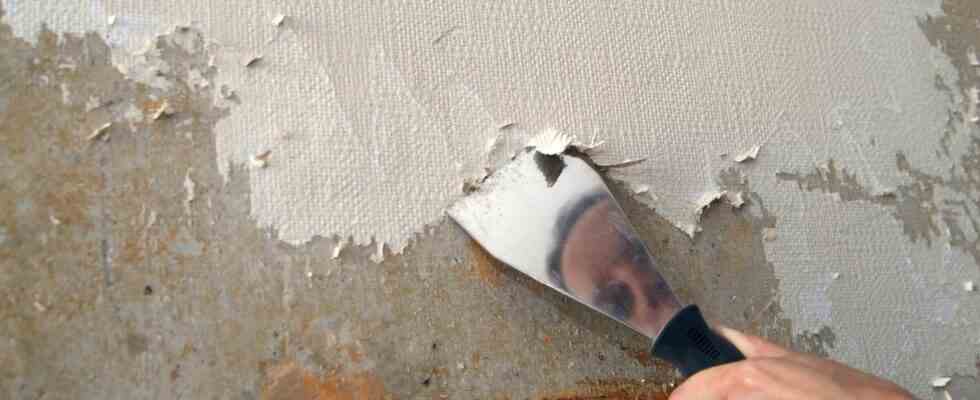Practical helper
Wallpaper remover, nail roller and Co.: These tricks make it easier to remove old wallpaper
Removing old wallpaper is a sweaty job
© kelvinjay / Getty Images
Pasting over old wallpaper entails several risks that you can avoid by detaching the strips. However, these are difficult to remove unless you use the following tricks.
To save time, outdated wallpaper is only too happy to simply be pasted over. The workload is significantly less, but the result is all the worse. Apart from the fact that existing bumps such as overlapping seams or bubbles also appear on the new strips, there is a real risk that the freshly applied paste will loosen the old wallpaper from the wall – and thus also the new ones. In addition, a smooth pattern does not look really smooth if there are layers of wallpaper with textures or woodchip underneath. Either way, you’ll be doing yourself and the wall a favor by removing the old wallpaper before installing new ones. How this works best is explained as follows.
Remove wallpaper in just three steps
If the old wallpaper is already coming off by itself, so that its edges or corners are sticking out, you would like to pull it off the wall in one go. Unfortunately, this is not possible because the paste still holds most of the strips in place. At the latest when you try to tear off the loose pieces, you will notice that the work is not done in a few simple steps. The right preparation, which is based on a sophisticated system that can be divided into three steps, is all the more important. These are as follows:
Step 1:
Soak and perforate wallpaper
To loosen the paste, you need to soak the wallpaper. For uncoated paper wallpaper three different methods are available. Either you use warm water and add a little washing-up liquid, or you use a special one wallpaper remover. To soak the walls as evenly as possible, a pressure sprayer – it edits the wallpaper across the board. As an alternative to the two aids mentioned, you can also use a special one steam wallpaper stripper grip, which soaks the paper wallpaper with the help of steam. Completely without chemicals.
Coated wallpaper, which have a water-repellent function, cannot be soaked as easily as those made of paper. They must first be perforated so that the water can penetrate to the paste. A so-called is best suited for this spiked roller: She scratches the wallpaper selectively so that moisture can penetrate through the material. The application is very easy and also protects the base coat, which should not be damaged for the new wallpaper. After perforating, you can apply the rinse water or the wallpaper remover with the pressure sprayer as usual.
Step 2:
peel off wallpaper
Let the rinsing water soak in until the strips turn dark – before you start removing the wallpaper. If you use a wallpaper remover, you should stick to the prescribed exposure time on the packaging. If you get to work too early, the strips will not come off cleanly, so you will have a lot of trouble scraping off the remains. Go to work calmly and patiently: slowly and carefully peel off the wallpaper and take one or more spatula to help if a sheet does not come off properly in some places on the wall. Alternatively, a wallpaper scraper be used.
Step 3:
repair imperfections
When you have removed all the wallpaper residue, the wall should be nice and smooth. If this is not the case, it makes sense to carry out a few minor repairs before changing the wallpaper – to remove any unevenness. Smaller hairline cracks, chipped plaster or holes in the walls can be repaired with putty. You can also add one deep primer (e.g. plaster, gypsum or concrete) before wallpapering, painting, plastering or filling. This means that the lengths can be easily peeled off the next time, which is especially true for woodchip wallpaper and paper wallpaper that has been coated several times.
One final tip: You can usually dispose of the leftover wallpaper in the residual waste. However, if you have particularly large quantities, you can take them to a recycling center.
You might also be interested in:
This article contains so-called affiliate links. There is more information here.

